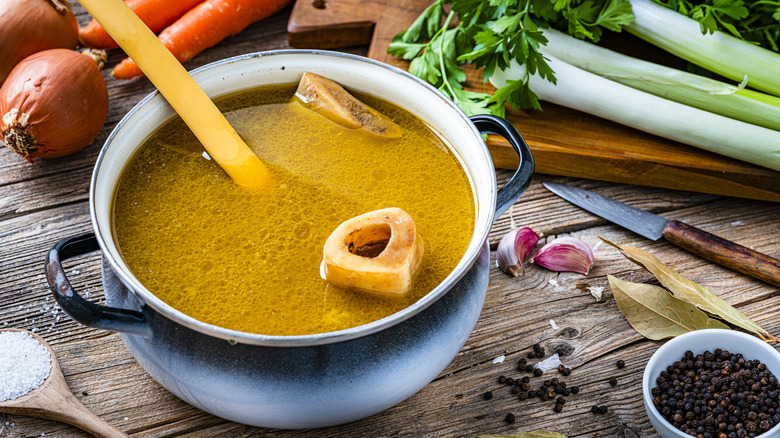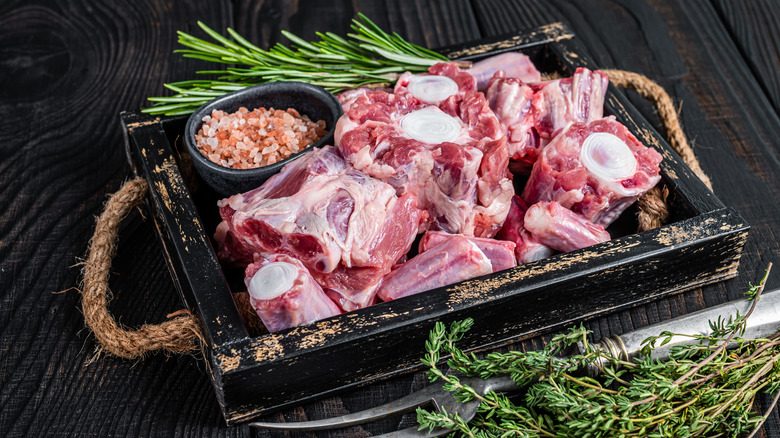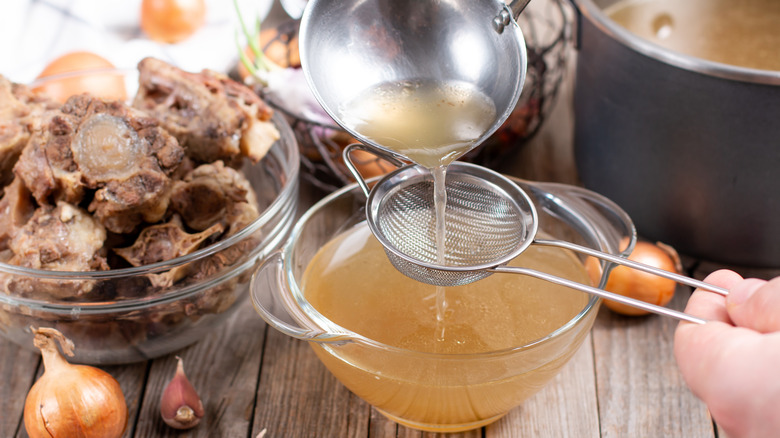Strategic Double Straining Is The Key To Perfect Bone Broth
Packed with collagen, protein, and flavor, bone broth is a popular drink of choice since the paleo diet craze brought it to wider public attention in the mid-2010s. While the price of bones may have gone up, it's still a popular choice to make at home. It is made by simmering bones and other ingredients for a long time in low heat until all the nutritional value of the bones has been dissolved into the broth. Devotees of bone broth claim that it is good for digestive health, improves immune response, promotes joint health, and even improves sleep.
Abundant with nutrients and flavor, bone broth is not only delicious on its own, but it is also a fantastic base for soups, stews, and anything that calls for stock. However, it is important to properly strain the broth before using it to filter out debris and unpleasant residue. When filtered properly multiple times, you end up with a particulate-free bone broth that is a versatile staple in your kitchen
Making bone broth
Despite being labeled a "broth," bone broth is just a variation of stock, something that humans have been making for millennia before 21st-century culinary trends brought it to public consciousness. The primary ingredients are bones, aromatics, and optional seasonings. It can be made with beef, pork, chicken, or any other bones that you can buy from your local butcher. As a general rule, bones that are rich in connective tissues such as oxtails and chicken wings are preferable as they contain more fat and collagen that imbue the broth with richness. You can also use marrow bones (which also go beautifully in State Bird Provisions' roasted bone marrow) or even short ribs and chicken carcasses. If you wish for a brown broth, roast the bones in a hot oven until well browned, but you can skip that step if you prefer a lighter-colored broth.
Aside from bones, you have a wide latitude over the choice of aromatics and seasonings. Garlic, celery, carrots, bay leaves, and parsley are popular. Put the bones and any aromatics you chose in a slow cooker, and cover everything with water. Cook on the slow setting for at least 12 hours, preferably 24. Alternatively, you can make the broth in a regular stock pot over the stove. To keep it clear, skim the foam and scum that floats to the surface periodically.
Strain, store, and use
Once finished, remove the pot from the heat and allow it to cool slightly. Strain everything through a colander to remove the large pieces of bones and aromatics, then once again through a fine mesh strainer lined with cheesecloth. The second straining removes any smaller bone and vegetable particulates that have broken off during the simmering process, leaving you with pure, delicious bone broth. Once cooled, you can store the broth in the fridge, and by the next day, you'll find the fat in the broth has floated to the top of the container, forming a semi-solid block that is easy to remove. Thanks to the collagen in the bones, the cold broth should have the consistency of jelly reminiscent of an aspic.
Bone broth can be used for many purposes. It can be drunk as-is (with additional seasonings, like salt) for a warming beverage, or used as a flavorful base for soups and stews. Bone broth also freezes well, and you can store it in an airtight container for up to three months.



